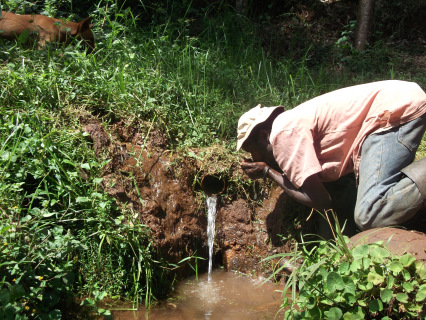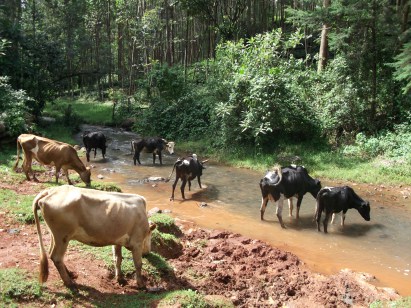Mzee Richard Kemei has been drinking clean water drawn from the nearby river of “Kipkororiet” since he was a young man over 50 years ago.

The now elderly Kemei says his late mother Mrs. Priscila Sigilai and other women drawn from the nearby village of Keongo in Kapkugerwet ward in Ainamoi have been using the water from Kipkororiet River for the various household needs including drinking, washing utensils and bathing.
Coming from the Kipsigis community, who are largely associated with livestock keeping, the locals also utilized the clean water to quench the thirst of their animals.
“The river has served us very well in all our domestic needs for as long as we can remember,” he says.
They have also been conducting various sacred traditional ceremonies in this river.
However, Kipkororiet River, which is one of the major inflow streams for the Tionosoyiet wetland about one kilometre downstream, might very soon turn out to be a danger to the locals. This is due to the rapid pollution of the water through discharge of raw sewer by the mushrooming residential areas around the river system.
“Again, these days when we drink the water drawn from the river, it tastes and smells of the soap used for washing clothes. This makes it impossible to drink,” he adds.
He attributes the foul taste to the number of people who bathe and wash, which has quadrupled in the last 10 years.
Locals, including the family of Mzee Kemei, are now forced to draw water from other smaller streams which feed Kipkororiet River to avoid exposure to diseases which are associated with pollution by the raw sewerage waste.

The area Village elder, Peter Marindany, says the water has been some of the cleanest in the country but now the threat of pollution was a risk to the health of the locals.
The Kipkororiet River has also shrunk greatly in the last 50 years, an incident which the locals attribute to clearing of forests, planting of Eucalyptus trees and encroachment of the town which is expanding rapidly.
As a community leader, Mr. Marinday, urges the locals to apply for piped water from the Kericho Water and Sanitation Company (KEWASCO) which he says is safe and reliable.
The shrinking of Kipkororiet river is not an isolated issue, since a neighbouring river of Ainapbelek has also shrunk over five times its size in the last 20 years. The low volume flowing to the wetland, which acts as a reservoir, is a threat to the ecosystem of the region.
Mzee Kemei and many others of his generation might know the meaning of good river water but are not well conversant with wetland conservation.
A survey done by the Ministry of Environment says Kericho town represented one of the most significant diffuse sources of pollution to the wetland, with sewage entering the wetland in the lower parts of the wetland, downstream.
It identified key areas within the town from which pollutants are likely to be derived as the market place, located about 500m from the southernmost point of the wetland, and spans about five hectares.
“Some of the activities at the market include open air sale of fresh food, grains, used and new clothes and household utensils. In addition, there is a terminal for public transport vehicles in the middle of the market area. The market area and matatu terminal are therefore likely to be significant sources of nutrients, sediments and gross pollutants,” it says.
The informal cottage industrial site (Jua Kali) contains artisans who fabricate a wide range of items including cooking pots, farm implements, vehicle spare parts, furniture and collection of recyclable materials among other products. Again this site is likely to contribute significant amounts of sediments, and gross pollutants into the wetland.
Other pollutants to Tionosoyiet include effluent from the KEWASCO Sewage Treatment Plant which is discharged into the wetland.
The densely populated Nyagacho informal residential area hosts a wide range of economic activities such as shops, garages, food outlets and butcheries. The area is not sewered, and has no organised solid waste collection systems. Much of the area drains into the wetland.
To save the situation, over 4,000 wetland-friendly tree seedlings have been planted in the wetland by the government and other stakeholders and, once they grew, the wetland will be turned into a nature trail/arboretum for recreation purposes.
Alternative livelihood activities such as fish farming and bee keeping within the wetland has also been introduced.
By Benedict Tirop
